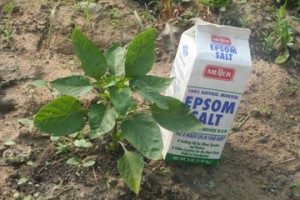Epson Salts
 Question from Philip:
Question from Philip:
I attended your lecture in April 2011 with the Master Gardeners where you mentioned to use Epson Salts on peppers.
I did and the results are amazing, I have the biggest green/red peppers I have ever seen. Someone in the audience ask if the solution could be used on tomatoes. I believe you answer that it couldn’t hurt.
I sprayed my six Beefmaster tomato plants with the same solution that I used on the peppers. Between one third to one half of the tomatoes has blossom end rot and sometimes rot on the side. The biggest tomato so far is 2 to 3 ounces. I have one Beefmaster that I had grown from seed and is now just ripening. I did not spray this tomato with the Epson Salt solution and I just pick my first 8 ounce tomato. The does have some blossom end rot but not the extent that the plants I sprayed with the Epson Salt solution. Could the Mg be taking the place of Ca?
Answer from Pat:
I am delighted to hear of your great success with the peppers and additional magnesium you gave them by spraying with a solution of 1 Tablespoon to 1 quart of water. My instructions were to do this when blossoms show but often folks forget that part and even then it seems to have a greatly good effect.
Tomatoes also need magnesium and I can’t think why that should interfere with the uptake of calcium. (But I am not an agricultural scientist.) As you already know, blossom end rot is caused by lack of calcium and since our local soils usually contain plenty of calcium, blossom end rot occurs here not because calcium sn’t available to roots but because the roots can’t access it unless the soil is evenly moist. That is, when the soil dries out or becomes soaking wet this causes blossom end rot. Wet and dry soil makes the plant unable to absorb the calcium that is already in the soil. Tomato roots naturally go far down in the ground and watering deeply and infrequently produces the correct conditions for them. A container-grown plant needs more frequent watering for the ground to stay moist inside the container, but drainage must be superior. If the soil in containers is soggy or too dry this causes blossom end rot.
Since many people have this problem in raised beds, I fear that your blossom end rot problems might have come from watering with a drip system. One would think that drip systems would keep soil evenly moist but they don’t. Much more often they lead to alternating wet and dry areas in the soil under the surface where we can’t see. The water from the drip system goes straight down and next to it is a place where there is no dripper and beneath that is dry soil. When tomatoes encounter this dry area they can’t get calcium and when the irrigated part is too wet they can’t get calcium there either. The result is blossom end rot.
Don’t be too discouraged about this because our local farm advisor of commercial tomato crops once told me that tomato farmers with their plants on drip suffer all the time from tomatoes getting blossom end rot. It is one of their worst problems he said and it’s caused by watering with a drip system. Farmers try to overcome it by feeding with Calcium nitrate.
I grew an enormous tomato plant this year in a raised bed and watered it only once a week with the hose by soaking the entire bed with water so it went in deeply all over. This produced completely disease-free tomatoes, and they are an heirloom variety too. (The variety is Carbon and it’s still going strong and still bearing now in August.) This plant was grown from seed by a friend and was a gift to me, so it was a strong clean plant in the beginning, like yours also.

